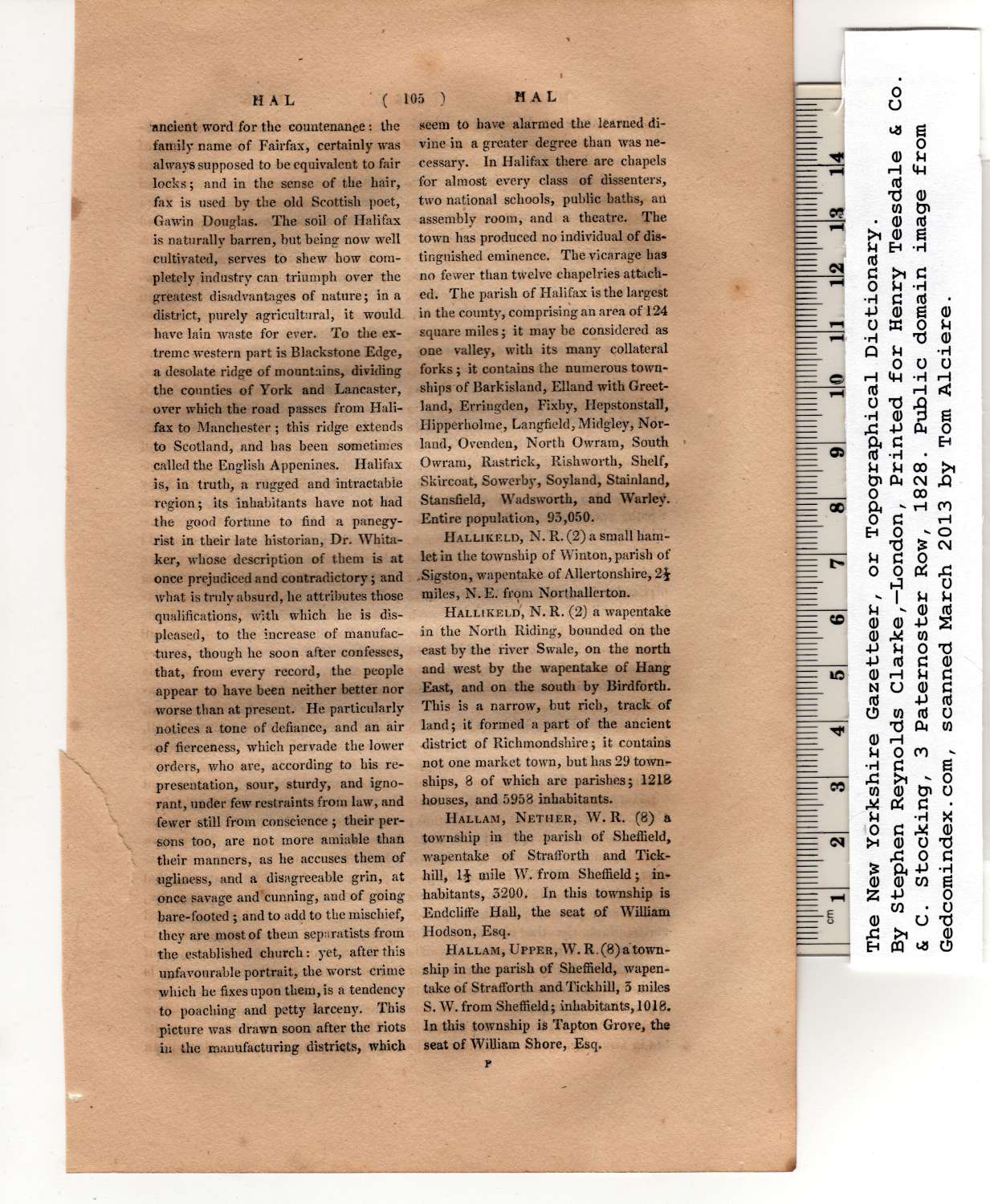|
ancient word for the countenance: the
family name of Fairfax, certainly was
always supposed to be equivalent to fair
locks; and in the sense of the hair,
fax is used by the old Scottish poet,
Gawin Douglas. The soil of Halifax
is naturally barren, but being now well
cultivated, serves to shew how com-
pletely industry can triumph over the
greatest disadvantages of nature; in a
district, purely agricultural, it would
have lain waste for ever. To the ex-
treme western part is Blackstone Edge,
a desolate ridge of mountains, dividing
the counties of York and Lancaster,
over which the road passes from Hali-
fax to Manchester; this ridge extends
to Scotland, and has been sometimes
called the English Appenines. Halifax
is, in truth, a rugged and intractable
region; its inhabitants have not had
the good fortune to find a panegy-
rist in their late historian, Dr. Whita-
ker, whose description of them is at
once prejudiced and contradictory; and
what is truly absurd, he attributes those
qualifications, with which he is dis-
pleased, to the increase of manufac-
tures, though he soon after confesses,
that, from every record, the people
appear to have been neither better nor
worse than at present. He particularly
notices a tone of defiance, and an air
of fierceness, which pervade the lower
orders, who are, according to his re-
presentation, sour, sturdy, and igno-
rant, under few restraints from law, and
fewer still from conscience ; their per-
sons too, are not more amiable than
their manners, as he accuses them of
ugliness, and a disagreeable grin, at
once savage and cunning, and of going
bare-footed ; and to add to the mischief,
they are most of them separatists from
the established church: yet, after this
unfavourable portrait, the worst crime
which he fixes upon them, is a tendency
to poacliing and petty larceny. This
picture was drawn soon after the riots
in the manufacturing districts, which
seem to have alarmed the learned di-
vine in a greater degree than was ne-
cessary. In Halifax there are chapels
for almost every class of dissenters,
two national schools, public baths, an
assembly room, and a theatre. The
town has produced no individual of dis-
tinguished eminence. The vicarage has
no fewer than twelve ehapelries attach-
ed. The parish of Halifax is the largest
in the county, comprising an area of 124
square miles; it may be considered as
one valley, with its many collateral
forks ; it contains the numerous town-
ships of Barkisland, Elland with Green-
land, Erringden, Fixby, Hepstonstall,
Hipperholme, Langfield, Midgley, Nor-
land, Ovenden, North Owram, South
Owram, Rastrick, Rishworth, Shelf,
Skircoat, Sowerbv, Soyland, Stainland,
Stansfield, Wadsworth, and Warley.
Entire population, 93,050. |
Hallikeld, N. R. (2) a small ham-
let in the township of Winton, parish of
.Sigston, wapentake of Aflertonshire, 2§
miles, N.E. from Northallerton.
Hallikeld, N. R. (2) a wapentake
in the North Riding, bounded on the
east by the river Swale, on the north
and west by the wapentake of Hang
East, and on the south by Birdforth.
This is a narrow, but rich, track of
land; it formed a part of the ancient
district of Richmondshire; it contains
not one market town, but has 29 town-
ships, 8 of which are parishes; 121S
houses, and 5958 inhabitants.
Hallam, Nether, W. R. (8) a
township in the parish of Sheffield,
wapentake of Strafforth and Tick-
hill, If mile W. from Sheffield; in-
habitants, 3200. In this township is
Endcliffe Hall, the seat of William
Hodson, Esq.
Hallam, Upper, W. R. (8) a town-
ship in the parish of Sheffield, wapen-
take of Strafforth and Tickhill, 3 miles
S. W. from Sheffield; inhabitants, 1018,
In this township is Tapton Grove, the
seat of William Shore, Esq,
p |
